Tahoe Lobster Company
January – February 2013
Why “clarity by cuisine?” Well, you have to know Lake Tahoe’s history with that pesky—yet yummy—intruder: the crayfish, aka crawdad or crawfish.
Story & Photos By Richard Massey
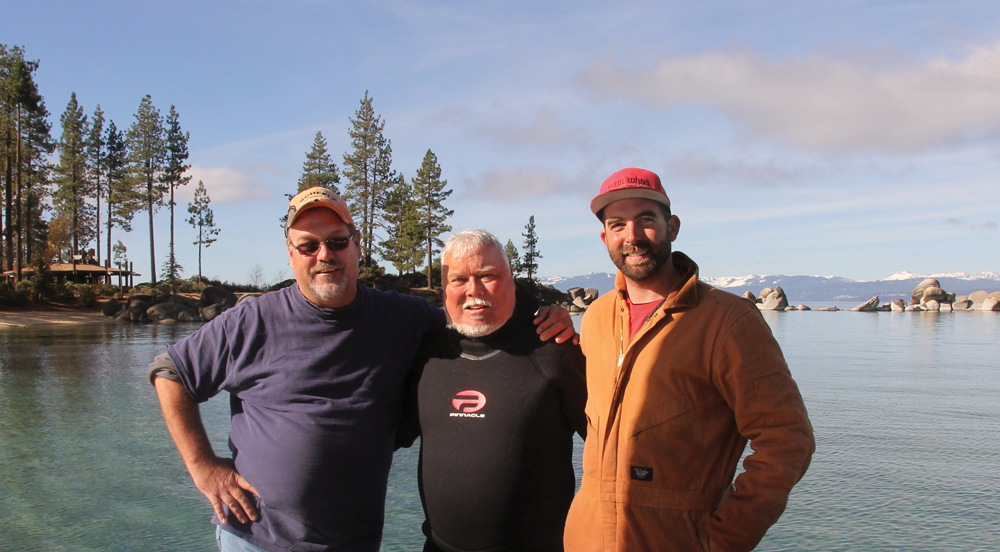
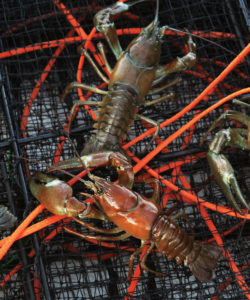 The story of the Tahoe Lobster Company begins with the first written introduction of signal crayfish in 1895: 19 males and 31 females in Marlette Lake. Since Marlette feeds into Lake Tahoe, the crayfish had no problem getting well established in both Nevada lakes.
The story of the Tahoe Lobster Company begins with the first written introduction of signal crayfish in 1895: 19 males and 31 females in Marlette Lake. Since Marlette feeds into Lake Tahoe, the crayfish had no problem getting well established in both Nevada lakes.
During this time the lumber and mining industries were going strong and an additional, inexpensive food source was needed. Popular belief was that the native Lahontan Cutthroat Trout—a natural predator of the crayfish—would thrive, and populations would grow to meet the demands of the basin for a food source. So, additional stocking of crayfish occurred in 1915 and throughout the ’20s. The crayfish prospered, and the plan was working. But there was a problem.
Due to heavy pressure from commercial fishing, the trout population was hit hard, and by the end of the 1930s native Lahontan cutthroat in Lake Tahoe were extinct. Without a predator, the crayfish population soared. Everyone seemed to forget about the small lobster-like crustacean, and no one questioned the long-term effect of introducing such an invasive species.
It wasn’t long before Mackinaws (lake trout) were introduced to fill the void left by the cutthroat. They thrived and seemed to be controlling the crayfish population. In an effort to accelerate the fish population, mysid shrimp were introduced. This variety of shrimp is a mid-water species and an easy catch for a Mackinaw. Although crayfish are still part of the Mackinaw’s diet, their status has moved from the main course to a la cart.
Today the Mackinaw and other introduced species are having little impact on the overpopulation of crayfish, a major factor in the degradation of water quality in Lake Tahoe. Crayfish are like grazing cattle. They are constantly eating and discharging excrement. Their natural fertilizer of phosphates and nitrates accelerates the growth of algae and other flora. As a result, the clarity and color of the water of the near-shore environment has dramatically changed over the years.
Crayfish can be found throughout the lake from the shoreline to a depth of about 900 feet. During the summer months they are likely to move into shallow, warm waters. When winter arrives, they move to deeper waters to avoid turbulence and fluctuating temperatures—the deeper water is free of currents and maintains a more constant temperature.
While the crayfish problem has been recognized, solutions have been harder to come by. Although strict regulations are in place to control motorboat emissions and other manmade contaminants, little has been done to address the crayfish problem. As Ted Thayer, program director for the Tahoe Regional Planning Agency’s aquatic invasive species program explains, “We just don’t have the money or manpower to deal with it.”
A Business is Born
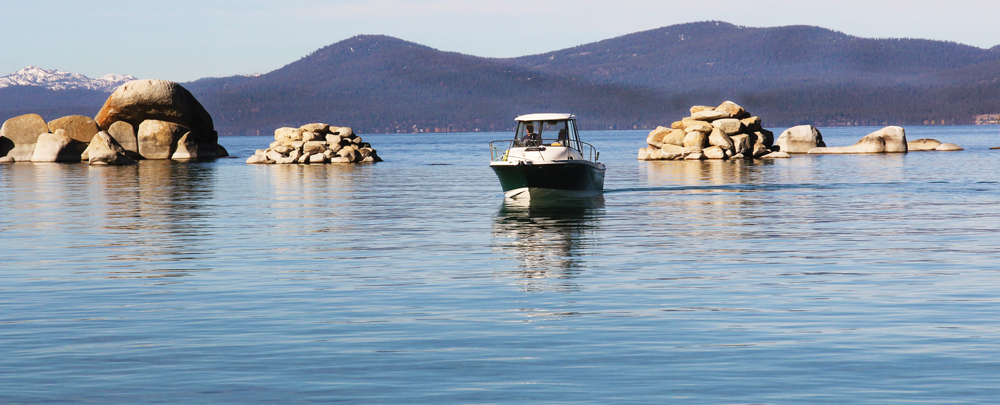
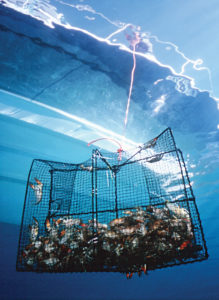 When wildlife manager Fred Jackson heard about Lake Tahoe’s crayfish problem, his mind began to wander with possible solutions. After all, problem solving has been a major part of his 23-year career in wildlife management, many of those years spent as assistant manager for the Mason Valley Wildlife Management Area in Yerington.
When wildlife manager Fred Jackson heard about Lake Tahoe’s crayfish problem, his mind began to wander with possible solutions. After all, problem solving has been a major part of his 23-year career in wildlife management, many of those years spent as assistant manager for the Mason Valley Wildlife Management Area in Yerington.
Working closely with the Nevada Department of Wildlife, Tahoe Regional Planning Agency, Nevada Division of State Lands, and Dr. Sudeep Chandra and his environmental team at the University of Nevada, Reno, a business plan began to develop. Thayer was delighted to see someone like Jackson with private-company aspirations become involved.
After Jackson met with civic leaders and made dozens of presentations to various organizations and committees, he was pleased to see that everyone had the same goal: to keep Lake Tahoe blue.
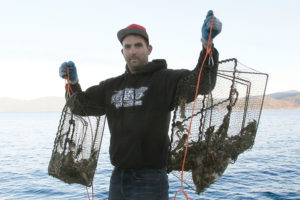
After two years of research and planning, in July 2012 the Tahoe Lobster Company received its Lake Tahoe commercial fishing permit. This was the first such permit issued since the 1930s. Jackson explains, “We are starting small. This really is a family business. My wife, Stephanie, is a co-owner and part-time captain. My nephew, Justin Pulliam, is a shareholder, deckhand, and part-time captain. It’s just the three of us.”
Jackson is cautiously optimistic about the future. He explains, “We have about 30 regular clients. These range from small family restaurants to the casinos in Tahoe, Reno, Carson City, Gardnerville, and Minden. Right now we can only harvest on the Nevada side of the lake.” Currently, California laws prohibit the commercial harvesting and sale of crayfish.

“At times we have trouble keeping up with the demand,” Jackson continues. “Having just one boat has been a problem. We would like to add a second boat and crew next summer. In addition to harvesting crayfish, we must keep accurate records to show our progress and what impact we are having.”
Each weekend the crew brings in about 200 pounds of crayfish, which are bagged on the boat before being delivered to Sierra Gold Seafood in Sparks. The fresh-caught crayfish are held live in cold storage before being delivered to vendors. Sierra Gold is a seafood wholesaler that promotes Tahoe Lobster Company’s crayfish sales, marketing, and distribution.
Jim Crowell, director of Sierra Gold Seafood, has more than a business interest when it comes to removing crayfish from Lake Tahoe. He remembers how beautiful and clear the water used to be. He would like his grandchildren to be able to appreciate it the way he once did.
Adam Bronson, executive chef at the Old Granite Street Eatery in Reno, demands quality and understands the profitability of having crayfish (also known as crawdads) on the menu. He recently added crawdad bisque. “My clients love it, and they are asking for additional crawdad dishes,” Bronson says. “I’m working on it!”
Jackson concludes, “Critical taste buds have determined that the crawfish from Lake Tahoe are far superior to their Louisiana counterparts. The meat is white and has a sweeter taste. They taste just like Maine lobster. Clarity by cuisine.”

CRAWDAD BISQUE RECIPE
By Adam Bronson, executive chef at Reno’s Old Granite Street Eatery.
STOCK
Crawdads; 2 pounds
Yellow onions, large dice; 1 each
Fennel stalks, large dice; 3 each
Carrots, large dice; 3 each
Parsley stems; 1 bunch
Thyme; 1 bunch
Lemons, halved; 1 each
Whole garlic, halved; 1 each
Whole black peppercorn; 2 tbsp
Bay leaves; 2 each
BISQUE
Brandy; 1/3 cup
Tomato paste; 1 1/4 cup
Heavy cream; 1 1/2 cup
Crawdad stock; 3 cups
Kosher salt to taste
Preparation and Cooking: Place stock ingredients in an appropriate-sized vessel with the addition of water just to cover. Simmer until the vegetables are completely soft. Strain through a fine strainer into another pot to reduce down to 3 cups. In a smaller pot, reduce the brandy by half. Add the remaining ingredients, and season with salt and simmer until the desired consistency is achieved. Enjoy!


